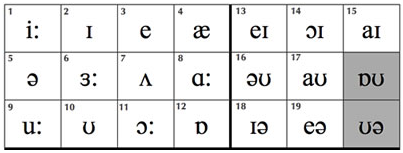Vowels in English.
Posted on Saturday, 8 December 2012
|
No Comments
From our childhood days we are taught about the English alphabet consisting of the vowels and consonants. Despite of this many people are unable to properly pronounce the English vowels. So we center our discussion around the ' Vowel Sounds in English' .
Now, the first question is, what is a vowel ? In phonetics, a vowel is a sound in spoken language which is pronounced with an open vocal tract so that there is no build up of air pressure at any point above the glottis.
Vowel sounds pose a considerable challenge to the non-native English speakers. Spoken English has an unusually high number of vowel sounds i.e. from five written vowels (a,e,i,o,u) we produce 19 vowel sounds (shown in the chart below).
There are three types of vowel sounds. They are :
Diphthongs are vowels in the production of which the tongue moves from one position in the mouth cavity towards another position. This movement is known as a glide. That means one vowel sound glides over another to form a diphthong. Therefore a diphthong is a combination of two vowel sounds represented by two phonetic symbols but these two symbols represent a single sound and not two sounds. There are 8 diphthongs in the English Repetitive Pronunciation.
Now, the first question is, what is a vowel ? In phonetics, a vowel is a sound in spoken language which is pronounced with an open vocal tract so that there is no build up of air pressure at any point above the glottis.
Vowel sounds pose a considerable challenge to the non-native English speakers. Spoken English has an unusually high number of vowel sounds i.e. from five written vowels (a,e,i,o,u) we produce 19 vowel sounds (shown in the chart below).
There are three types of vowel sounds. They are :
- Monophthongs (1,2,3,4,6,7,8,9,10,11,12 in the diagram)
- Diphthongs (13,14,15,16,17,18,19 in the diagram)
- Weak vowels (1,2,5,9 in the diagram)
To identify vowels we must have knowledge about the following:
- The shape of the lips
- The shape of the tongue
- Spreaded
- Neutral (natural)
- rounded
Monophthong is a pure vowel sound , one whose articulation at the beginning and end is relatively fixed, and which does not glide up and down towards a new position of articulation. We can also say that a vowel sound whose quality does not change over the duration of the vowel is called as a monophthong.
A monophthong can again be classified into :
- short monophthongs (2, 3, 4, 7, 10, 12 in the diagram)
- long monophthongs (1, 6, 8, 9, 11 in the diagram)
Diphthongs are vowels in the production of which the tongue moves from one position in the mouth cavity towards another position. This movement is known as a glide. That means one vowel sound glides over another to form a diphthong. Therefore a diphthong is a combination of two vowel sounds represented by two phonetic symbols but these two symbols represent a single sound and not two sounds. There are 8 diphthongs in the English Repetitive Pronunciation.
Traditional long and short vowels in English orthography:
Traditionally, the vowels /eɪ iː aɪ oʊ juː/ (as in bait beet bite boat beauty) are said to be the "long" counterparts of the vowels /æ ɛ ɪ ɒ ʌ/ (as in bat bet bit bot but) which are said to be "short". This terminology reflects their pronunciation before the Great Vowel Shift.
Traditional English phonics teaching, at the preschool to first grade level, often used the term "long vowel" for any pronunciation that might result from the addition of asilent E (e.g., like) or other vowel letter as follows:
| Letter | "Short" | "Long" | Example |
|---|---|---|---|
| A a | /æ/ | /eɪ/ | "mat" / "mate" |
| E e | /ɛ/ | /iː/ | "pet" / "Pete" |
| I i | /ɪ/ | /aɪ/ | "twin" / "twine" |
| O o | /ɒ/ | /oʊ/ | "not" / "note" |
| U u | /ʌ/ | /juː/ | "cub" / "cube" |
A mnemonic was that each vowel's long sound was its name.
In Middle English, the long vowels /iː, eː, ɛː, aː, ɔː, oː, uː/ were generally written i..e, e..e, ea, a..e, o..e, oo, u..e. With the Great Vowel Shift, they came to be pronounced /aɪ, iː, iː, eɪ, oʊ, uː, aʊ/. Because ea and oo are digraphs, they are not called long vowels today. Under French influence, the letter u was replaced with ou(or final ow), so it is no longer considered a long vowel either. Thus the so-called "long vowels" of Modern English are those vowels written with the help of a silent e.
And, finally, the weak vowels. The weak vowels are confined to weak, unstressed syllables. These weak vowels resemble the three finishing points of three different kinds of English diphthong; they are pronounced with the tongue in either a front-close position, a back-close position, or a central position. All the short and long vowels introduced already are all strong vowels used in strong and stressed syllables.




